Ming Imperial Mausoleum: Where History Meets Serenity
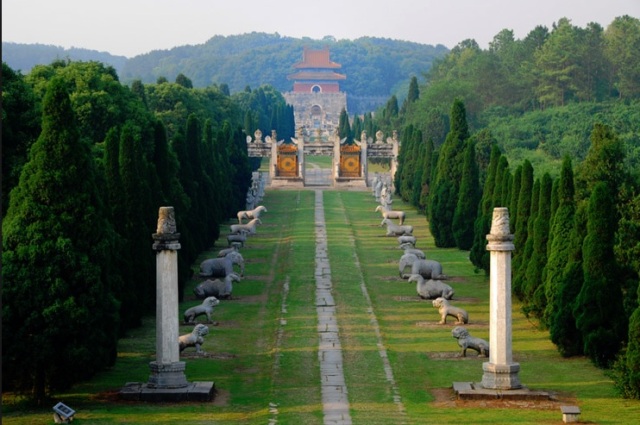
An Essential Guide to Visiting Ming Imperial Mausoleum
Nestled within the serene embrace of Tianshou Mountain, approximately 50 kilometers northwest of Beijing, lies a monumental testament to China’s imperial past—the Ming Imperial Mausoleum. This sprawling necropolis, often referred to as the “Thirteen Ming Tombs,” serves as the final resting place for 13 emperors, alongside their empresses, concubines, and princes, spanning from the Ming Dynasty (1368–1644).
A visit to this UNESCO World Heritage site is not just a journey through ancient burial practices but an immersive experience into the grandeur and complexities of a dynasty that shaped China’s history. With its lush landscapes, majestic architecture, and profound cultural significance, the Ming Imperial Mausoleum encapsulates the very essence of imperial authority and the intricate beliefs surrounding death and the afterlife in ancient China.
As you wander along the Sacred Way, flanked by lifelike stone statues that once served as guardians to the emperors, you’ll find yourself transported back in time. Each tomb, uniquely designed and steeped in symbolism, tells a story of power, legacy, and the quest for immortality. Whether you choose to explore the expansive grounds of Changling, the underground wonders of Dingling, or the tranquil Zhaoling, each step offers a glimpse into the opulent world of Chinese royalty.
Prepare to be captivated by the rich tapestry of history that unfolds at the Ming Imperial Mausoleum, where the echoes of the past resonate through the tranquil hills, inviting you to discover the secrets of a bygone era. This guide will equip you with essential information to make the most of your visit, ensuring that your journey through this extraordinary site is as memorable as the emperors it honors.
In This Guide
- An Essential Guide to Visiting Ming Imperial Mausoleum
- The Rich History and Legends of Ming Imperial Mausoleum
- Main Highlights: What You Absolutely Can’t Miss
- Planning Your Visit: A Practical Guide
- Tickets: Prices, Booking, and Tips
- How to Get There: A Complete Transportation Guide
- Local Cuisine and Accommodation Nearby
- Frequently Asked Questions
- Final Thoughts on Your Trip
The Rich History and Legends of Ming Imperial Mausoleum
The Ming Imperial Mausoleum, nestled within the picturesque Tianshou Mountain region, stands as a testament to the grandeur and mystique of the Ming Dynasty, which flourished from 1368 to 1644. Spanning over 120 square kilometers, this magnificent site is the final resting place for 13 emperors, alongside numerous empresses, concubines, and princes, making it a significant cultural and historical landmark.
Construction of these mausoleums began under the reign of the third emperor, Zhu Di, also known as the Yongle Emperor, in 1409. His vision was to create a burial site that not only honored the deceased but also ensured the longevity and prosperity of his dynasty. This ambitious project spanned more than 200 years and was completed only with the fall of the Ming Dynasty in 1644. The careful planning and architectural mastery involved in the construction reflect the deep-rooted beliefs in Feng Shui, which guided the selection of this auspicious location. Tianshou Mountain, with its protective hills and flowing river, was seen as a “comfortable chair,” symbolizing stability and harmony.
The Ming Tombs are characterized by their grand architecture and intricate designs. Each tomb is uniquely crafted, with Changling, the largest and most significant, housing the remains of the Yongle Emperor and his empress Xu. Visitors can marvel at the Hall of Eminent Favor, a majestic wooden structure supported by 60 golden Nanmu columns, where sacrificial ceremonies were held. The exhibition within the hall offers insights into Emperor Zhu Di’s achievements, shedding light on his influential role in Chinese history.
Dingling, the tomb of the Wanli Emperor, is particularly notable for its excavated underground palace, which provides a rare glimpse into the burial practices of the time. The palace, filled with exquisite artifacts, showcases the wealth and artistry of the Ming era. Among the treasures are gold and silk items, which reflect the high level of craftsmanship that defined the period.
The Sacred Way, also known as the “Way of God,” serves as the ceremonial pathway leading to the tombs. Lined with intricately carved stone statues of animals and human figures, it symbolizes the emperor’s supreme authority and his guardianship over the afterlife. Each statue, crafted from a single piece of stone, tells a story of the past, allowing visitors to feel the weight of history with every step they take.
The legends surrounding the Ming Imperial Mausoleum have also contributed to its mystique. Tales of the emperors’ desires for immortality and the elaborate rituals performed to ensure safe passage to the afterlife enrich the narrative of this historical site. The careful preservation and restoration efforts undertaken by the Chinese government have safeguarded this cultural heritage, ensuring that future generations can explore the stories of those who shaped China’s history.
Visiting the Ming Imperial Mausoleum is not merely a journey through ancient architecture; it is an exploration of a rich tapestry of history, culture, and legend that continues to enchant all who walk its sacred grounds. Whether you are captivated by the grandiose tombs, the intricate art, or the legends of the past, the Ming Imperial Mausoleum offers a profound connection to China’s imperial legacy, inviting travelers to reflect on the grandeur of an era long gone but never forgotten.
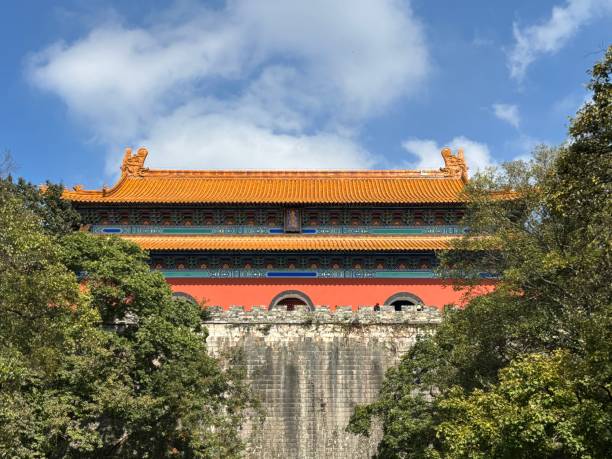
Ming Imperial Mausoleum.
Main Highlights: What You Absolutely Can’t Miss
The Ming Imperial Mausoleum, a UNESCO World Heritage Site, is a treasure trove of history nestled in the serene Tianshou Mountain area, just 50 kilometers northwest of Beijing. This magnificent complex is the final resting place for 13 Ming Dynasty emperors, their empresses, concubines, and princes, making it an essential stop for any traveler keen on exploring China’s imperial past. Here are the main highlights you absolutely can’t miss during your visit:
Changling Tomb: The Grand Entrance
Changling, the first and largest of the 13 tombs, is a must-see. This architectural marvel houses the tomb of Emperor Zhu Di, the third emperor of the Ming Dynasty. As you enter, take a moment to admire the Hall of Eminent Favor, one of the largest wooden structures in China, supported by 60 stunning golden Nanmu columns. Inside, you’ll find exhibitions detailing Zhu Di’s remarkable achievements, offering insight into the life of this influential emperor.
Dingling Tomb: A Glimpse into the Underground Palace
Dingling is particularly unique as it features the only excavated underground palace in the Ming Tombs. Here, you can explore the intricate underground chambers, which include diamond walls and three coffins, surrounded by a collection of over 3,000 precious artifacts, including exquisite gold and silk items. The remarkable craftsmanship of these relics showcases the opulence of the Ming Dynasty and its burial customs. Don’t miss the museum adjacent to the Soul Tower, which vividly narrates the excavation process and its findings.
The Sacred Way: Pathway of the Ancestors
The Sacred Way, or “Way of God,” is a beautifully landscaped access route leading to the tombs. Lined with 24 stone animals and 12 human figures, these statues serve as guardians for the emperors and are a testament to the artistic skills of their era. The intricate carvings and lifelike details will leave you in awe, making this pathway not just a route, but a journey through history.
Zhaoling Tomb: The “Dumb Courtyard”
At the Zhaoling Tomb, dedicated to the Longqing Emperor, be sure to visit the Dumb Courtyard. Its unique name reflects its tranquil, secluded atmosphere, providing a reflective space between the ceremonial areas and the burial chamber. This hidden gem adds a layer of serenity to your exploration of the mausoleum.
Scenic Surroundings: Nature’s Embrace
The Ming Tombs are not just about the tombs themselves; the surrounding landscape is equally captivating. The Tianshou Mountain range provides a stunning backdrop, embodying the principles of Feng Shui that guided the tomb’s placement. As you walk through the expansive grounds, take a moment to appreciate the harmonious relationship between the architecture and the natural environment, enhancing the spiritual significance of the site.
Practical Tips for Your Visit
- Best Time to Visit: Spring (April to June) and Autumn (September to November) offer pleasant weather and beautiful scenery.
- Accessibility: Most areas are wheelchair-friendly, although Dingling’s underground palace is not accessible.
- Tickets: Purchase tickets on-site or via WeChat. For those planning to visit multiple tombs, a combined ticket is the most economical choice.
- Guided Tours: Consider joining a guided tour to enrich your understanding of the site’s history and cultural significance.
By immersing yourself in the grandeur of the Ming Imperial Mausoleum, you will not only witness the architectural brilliance of ancient China but also gain a profound appreciation for the intricate burial customs of the Ming Dynasty. This captivating journey into the past is sure to leave a lasting impression on all who visit.
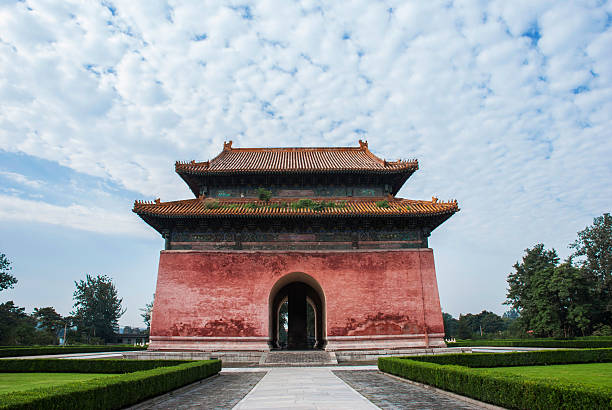
Ming Imperial Mausoleum.
Planning Your Visit: A Practical Guide
Planning Your Visit: A Practical Guide
If you’re looking to delve into the rich history of China’s Ming Dynasty, a visit to the Ming Imperial Mausoleum, also known as the Ming Tombs, is an absolute must. Nestled in the scenic Tianshou Mountain area just 50 kilometers northwest of Beijing, this UNESCO World Heritage site offers a unique glimpse into the life and afterlife of 13 emperors, their empresses, and other royal family members. To help you make the most of your trip, here’s everything you need to know before visiting.
Location and Getting There
The Ming Tombs are located in Changping County, surrounded by majestic mountains and lush landscapes. The mausoleum complex covers over 120 square kilometers, making it an expansive site to explore.
- Travel Options:
- By Public Transport: You can take Bus 314 from the Deshengmen station in Beijing. It will take you directly to the Ming Tombs.
- By Private Car or Taxi: For convenience, especially if you’re visiting multiple tombs, consider hiring a private vehicle. This will give you the flexibility to explore at your own pace without the hassle of public transit schedules.
Opening Hours
The site is open daily from 8:30 AM to 5:00 PM. It’s advisable to arrive early to avoid crowds, especially during peak tourist seasons.
Ticket Information
Tickets can be purchased on-site or via the WeChat public account (昌平文旅集团). If you plan to visit more than one tomb, a combined ticket can save you some money. These combined tickets are available at the Sacred Way, Changling, and Dingling.
- Entry Fees: Prices may vary based on the specific tombs you wish to visit, so check the latest rates before your visit.
What to See
While there are 13 tombs in total, only three are open to the public:
-
Changling (Tomb of the Yongle Emperor): The largest and first completed tomb, Changling features an impressive architectural complex with the Hall of Eminent Favor, where sacrificial ceremonies were held.
-
Dingling (Tomb of the Wanli Emperor): The only tomb with an excavated underground palace, Dingling showcases a wealth of artifacts, including the Emperor’s three coffins and thousands of burial objects in its exhibition rooms.
-
Zhaoling (Tomb of the Longqing Emperor): Although less known, Zhaoling’s Soul Tower and the unique “Dumb Courtyard” provide insight into the burial customs of lesser-known emperors.
The Sacred Way: This ceremonial path lined with stone statues of animals and officials leads you to the tombs and is a highlight of the visit, showcasing the artistry of ancient Chinese craftsmanship.
Suggested Itineraries
For a well-rounded experience, consider the following routes:
- Route 1: Sacred Way → Dingling → Changling → Zhaoling (Approximately 2.5 hours)
- Route 2: Sacred Way → Changling (1.5 hours)
- Route 3: Sacred Way → Dingling (1.5 hours)
Each of these routes allows you to immerse yourself in the history and grandeur of the Ming Dynasty.
Accessibility
Most of the tombs are wheelchair-friendly, with the exception of the underground palace at Dingling. If you’re traveling with someone who requires accessibility accommodations, be sure to inform your tour provider in advance to ensure a smooth experience.
Tips for Your Visit
- Wear Comfortable Shoes: You’ll be walking a lot, so comfortable footwear is essential.
- Bring Water and Snacks: While there are some facilities, having your own refreshments can be convenient, especially on warmer days.
- Consider a Guide: Hiring a local guide can enrich your experience with insights and stories that bring the history to life.
- Best Time to Visit: Early morning or late afternoon visits can help you avoid the busiest crowds and offer beautiful lighting for photographs.
Conclusion
A visit to the Ming Imperial Mausoleum is not just a journey through history; it’s an opportunity to connect with the cultural heritage of China. Whether you’re an avid history buff or simply looking to enjoy the scenic beauty of the site, the Ming Tombs promise an unforgettable experience. Prepare well, and you’ll leave with memories that last a lifetime.
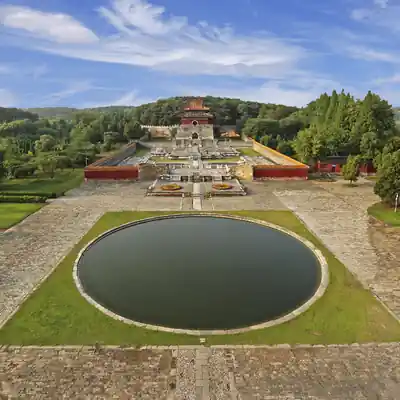
Ming Imperial Mausoleum.
Tickets: Prices, Booking, and Tips
Visiting the Ming Imperial Mausoleum is a captivating journey into China’s imperial past, and understanding the ticketing process can enhance your experience. Here’s what you need to know about tickets, prices, and booking tips for this historic site.
Ticket Information and Pricing
-
Entry Tickets: Individual tickets for the Ming Tombs can be purchased on-site at each of the three main tombs open to the public: Changling, Dingling, and Zhaoling. Prices typically range around 40 CNY (approximately $6 USD) for each tomb.
-
Combined Tickets: If you plan to explore more than one tomb, consider purchasing a combined ticket which offers a more economical option. This can be bought at the Sacred Way, Changling, and through the WeChat public account (昌平文旅集团). The combined ticket allows access to multiple sites, making it a great value for visitors.
-
Discounts: Discounts may be available for students, seniors, and groups, but be sure to check the latest information at the ticket counter or online.
Booking Tips
-
On-Site Purchase: Tickets can be easily purchased on-site, which is convenient for spontaneous visits. However, during peak tourist seasons or weekends, it might be wise to arrive early to avoid long lines.
-
WeChat Booking: For tech-savvy travelers, purchasing tickets via WeChat is a quick and efficient option. Ensure you have the WeChat app downloaded and set up before your visit.
-
Planning Your Visit: The Ming Tombs are open daily from 8:30 AM to 5:00 PM. Consider visiting later in the day to enjoy a less crowded experience, particularly if you arrive after exploring nearby attractions like the Great Wall.
Accessibility Considerations
Most areas of the Ming Tombs are wheelchair-friendly, making it accessible for all visitors. However, note that the underground palace at Dingling is not wheelchair accessible. If your group includes wheelchair users, it’s advisable to mention this when planning your visit to ensure a suitable travel plan.
Getting There
While there is no shuttle service between the tombs, having a private car or arranging transportation can greatly enhance your visit, allowing you to explore at your own pace and convenience.
Conclusion
A visit to the Ming Imperial Mausoleum is a profound way to connect with China’s rich history. With straightforward ticketing options and a variety of visits available, planning your trip can be stress-free. Embrace the opportunity to wander through this magnificent site and discover the stories of the emperors who once ruled China.
How to Get There: A Complete Transportation Guide
Getting to the Ming Imperial Mausoleum
Visiting the Ming Imperial Mausoleum, also known as the Ming Tombs, is a captivating experience that immerses you in the rich history of the Ming Dynasty. Situated approximately 50 kilometers northwest of Beijing, this UNESCO World Heritage site is easily accessible by various modes of transportation. Here’s a comprehensive guide to help you navigate your way to this historical treasure.
By Car
Self-Drive: If you prefer the flexibility of driving, renting a car is a great option. The journey from central Beijing to the Ming Tombs takes around one hour, depending on traffic. You can take the Badaling Expressway (G6) and follow the signs to Changping, where the tombs are located. Parking is available on-site.
Taxi or Ride-hailing Services: Using a taxi or ride-hailing app like Didi is convenient for travelers who may not wish to navigate public transport. Ensure that you specify the Ming Tombs or Ming Imperial Mausoleum to your driver. The fare from downtown Beijing typically ranges from 150 to 250 RMB.
By Public Transportation
Subway and Bus Combination: For budget-conscious travelers, public transport is a viable option.
- Take the Subway: Start by taking Line 2 (the Ring Line) to Xizhimen Station, then transfer to Line 13.
- Transfer to Line 13: Ride until you reach Changping Station.
- Bus Ride: From Changping Station, catch Bus 872 or Bus 314, both of which head directly to the Ming Tombs. The bus ride will take approximately 30-40 minutes.
This method is economical, with a total cost of around 10-20 RMB, but be prepared for a longer travel time of approximately 2-2.5 hours.
By Tour Group
Joining an organized tour is an excellent way to visit the Ming Tombs, especially for first-time visitors. Many tour operators in Beijing offer packages that combine visits to the Ming Tombs with other attractions, such as the Great Wall. This option typically includes transportation to and from your hotel, along with a knowledgeable guide to enhance your experience.
Accessibility Considerations
For travelers with mobility challenges, most areas of the Ming Tombs are wheelchair friendly, with the exception of the underground palace at Dingling. It’s advisable to inform your tour operator or the transportation service about any specific accessibility needs ahead of time.
Final Thoughts
Whichever transportation method you choose, the journey to the Ming Imperial Mausoleum is well worth it. This vast site, showcasing the grandeur of the Ming Dynasty, allows visitors to step back in time and appreciate the historical significance of these royal tombs. Plan your visit accordingly, and immerse yourself in the rich tapestry of China’s imperial past.

Ming Imperial Mausoleum.
Local Cuisine and Accommodation Nearby
When visiting the Ming Imperial Mausoleum, exploring the surrounding area can enhance your experience, especially when it comes to indulging in local cuisine and finding comfortable accommodation. Here are some delightful recommendations to make your visit even more enjoyable.
Local Cuisine
-
Changping District’s Traditional Dishes
Just a short drive from the mausoleum, you’ll find a number of local eateries that serve authentic Beijing cuisine. Try the Peking Duck, a dish renowned for its crispy skin and tender meat, often served with thin pancakes, sweet bean sauce, and sliced vegetables. For a lighter option, Jiaozi (dumplings) are a must-try, especially during the colder months. Many restaurants in the area offer these delectable treats, giving you a taste of local flavors. -
Xiaoyuan Restaurant
Located approximately 10 minutes from the mausoleum, Xiaoyuan is a popular spot for visitors looking to experience traditional Chinese dishes in a cozy setting. Their hot pot is highly recommended, allowing you to cook fresh ingredients at your table. It’s a great way to socialize and enjoy a meal with friends or family. -
Noodle House
If you’re in the mood for something quick and satisfying, head to one of the local noodle houses. Here, you can savor Zhajiangmian, a dish of wheat noodles topped with a rich, savory soybean paste, fresh vegetables, and sometimes minced pork. It’s a comforting meal after a day of exploring.
Accommodation Nearby
-
Changping Hotel
Located conveniently close to the Ming Tombs, the Changping Hotel offers comfortable accommodations with modern amenities. Guests can enjoy spacious rooms, an on-site restaurant serving local cuisine, and easy access to the mausoleum and surrounding attractions. This hotel is perfect for those looking for a relaxing stay after a day of sightseeing. -
Beijing Longhua Hotel
This hotel is a bit more upscale, featuring elegantly designed rooms and a beautiful garden. It’s set within a serene environment, perfect for unwinding after your visits. The hotel also offers a shuttle service to major attractions, making it a convenient option for travelers. -
Airbnb Options
For a more personalized experience, consider booking an Airbnb nearby. There are various options ranging from cozy apartments to traditional courtyard homes that allow you to immerse yourself in local culture. Many hosts offer insights into the area, including the best places to eat and explore.
Whether it’s enjoying a hearty meal of local delicacies or finding a peaceful place to stay, the area surrounding the Ming Imperial Mausoleum has plenty to offer. Be sure to take a break from your sightseeing to savor everything this beautiful region has to offer!
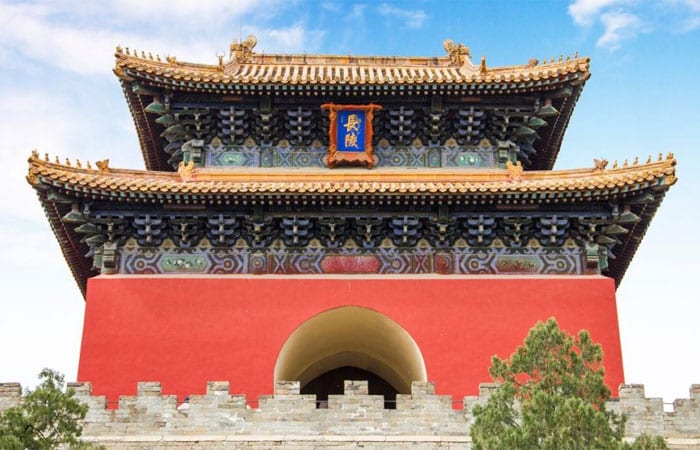
Ming Imperial Mausoleum.
Frequently Asked Questions
Frequently Asked Questions about the Ming Imperial Mausoleum
-
Where is the Ming Imperial Mausoleum located?
The Ming Imperial Mausoleum, also known as the Ming Tombs, is situated approximately 50 kilometers northwest of Beijing, within the Tianshou Mountain area of Changping County. -
What are the opening hours for the Ming Tombs?
The site is open daily from 8:30 AM to 5:00 PM. It’s advisable to arrive early to make the most of your visit. -
How many tombs can I visit at the Ming Tombs?
While the complex includes 13 tombs, only three are accessible to the public: Changling, Dingling, and Zhaoling. Each offers a unique glimpse into imperial history. -
Is the site accessible for wheelchair users?
Most areas of the Ming Tombs are wheelchair-friendly; however, the underground palace of Dingling is not accessible. Wheelchair users can still enjoy the exhibition rooms at Dingling. -
How can I buy tickets for the Ming Tombs?
Tickets can be purchased on-site or via the WeChat public account (昌平文旅集团). If you plan to visit multiple tombs, consider buying a combined ticket for better value, which is available at the Sacred Way and Changling. -
What is the best way to tour the Ming Tombs?
The most convenient way to explore the tombs is by private car, as there are no shuttle services between the sites. There are several recommended routes, ranging from 1 to 2.5 hours depending on how many tombs you wish to see. -
What can I expect to see at the tombs?
Highlights include the majestic architecture of Changling, the unique underground palace at Dingling, and the impressive stone statues lining the Sacred Way. Each site is rich in history and cultural significance. -
Are there any guided tours available?
Yes, many local tour companies offer guided tours of the Ming Tombs, which can enhance your experience by providing in-depth historical context and ensuring you don’t miss any essential details.
Final Thoughts on Your Trip
As you conclude your exploration of the Ming Imperial Mausoleum, take a moment to reflect on the profound history that envelops this remarkable site. The Ming Tombs, set against the picturesque backdrop of Tianshou Mountain, are not just a testament to the grandeur of the Ming Dynasty, but also a window into the rich tapestry of Chinese culture and beliefs surrounding life, death, and the afterlife.
Each tomb tells a story—a narrative woven through the ages, echoing the might and majesty of the emperors who shaped China’s history. Strolling along the Sacred Way, with its intricate stone guardians and serene landscapes, you can almost hear the whispers of the past, urging you to appreciate the artistry and craftsmanship that have stood the test of time.
Whether you found solace in the quiet grandeur of Changling, marveled at the underground wonders of Dingling, or simply enjoyed the tranquil beauty of the surroundings, the Ming Tombs invite you to carry a piece of their legacy with you. They remind us that while dynasties may rise and fall, the stories, culture, and spirit of a nation endure.
As you depart, we hope you leave with a deeper understanding of China’s imperial history and a sense of connection to a bygone era. Your visit to the Ming Tombs is not merely a journey through history; it is an invitation to embrace the essence of a culture that continues to thrive today. Safe travels, and may your adventures in China inspire you for years to come!